Action Competence Approach in a Nutshell
This is an approach that seeks to develop a student’s skills, knowledge, motivation and self-confidence in taking their own decisions in relation to a given issue (e.g. health or environmental concerns). The approach is partly a response to the lack of democracy in most schools; after all, students are rarely offered opportunities to choose what to do.
In order to build the capacity of students to make decisions and be responsible for their choices, the action competence approach provides them with opportunities to engage with issues in their community beyond the classroom. One way of approaching this can be summed up as, IVAC:
- Investigation
- Vision
- Action
- Change
The students take the lead in investigating the background to an issue of their choice. They not only explore what is happening, they also need to find out why this has occurred and who is responsible.
At the vision stage, students think about how this situation could be improved; what’s their vision for change? They then decide on an action that can help to bring about their vision.
The term ‘action’ has a specific meaning in action competence. It must be done with a specific change in mind AND it must be something that the students have decided to do themselves. If they are simply doing what they are told, then this is merely an activity. This is summarised in Fig. 2:

The process is completed by the students evaluating any change that may have taken place as a result of their action.
We do hope that you will develop opportunities for such democratic, action-based learning when you organise field trips based on our suggestions. We wish you luck with your endeavours!
Reference: Jensen B B & Schnack K (1997) The Action Competence Approach in Environmental Education, Environmental Education Research, 3:2, 163-178
Student Projects
Poland
Latvia
Romania
Spain

